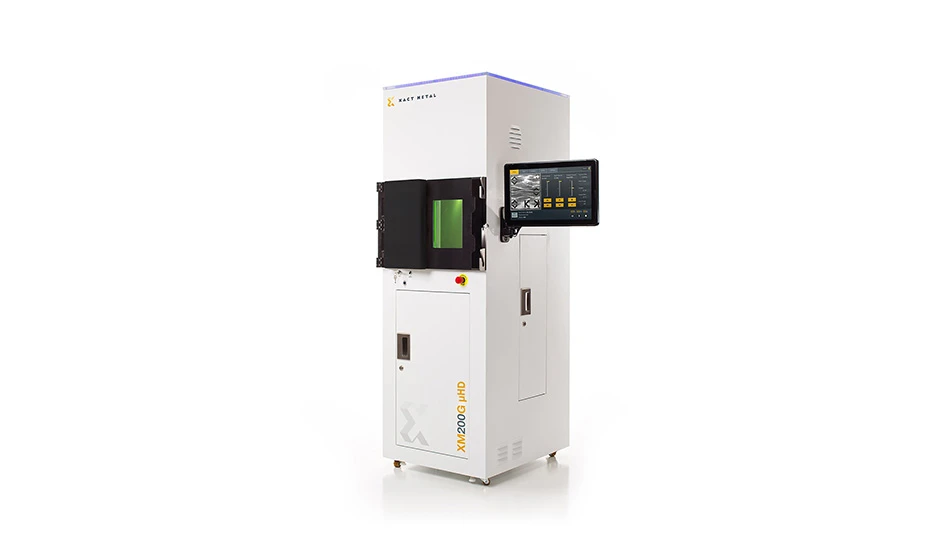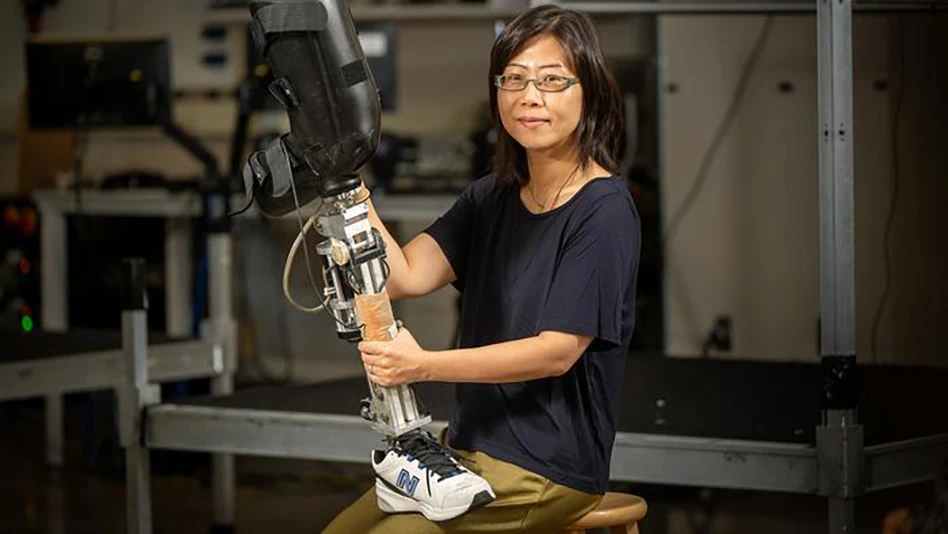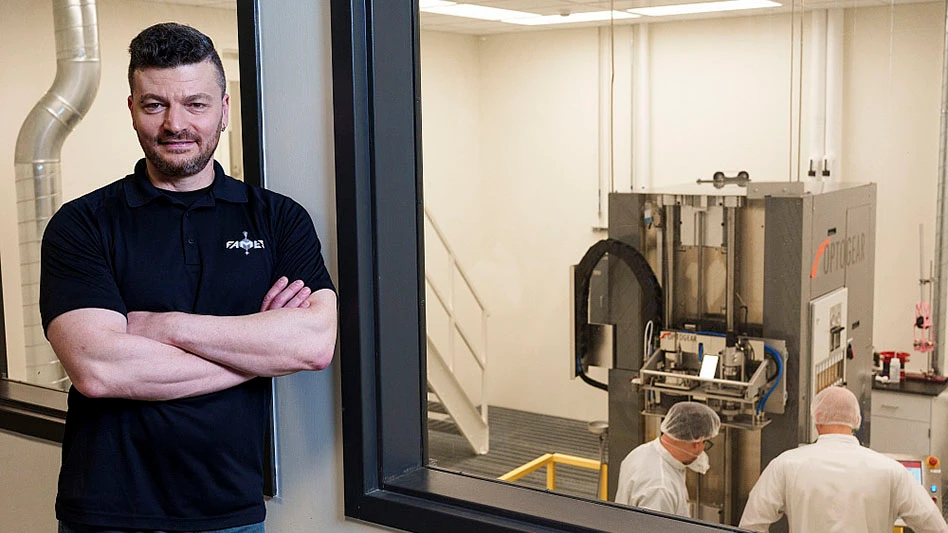John Vanderwerp is quality control manager for a unique custom-manufacturing operation at the Indiana University Cyclotron Facility (IUCF) in Bloomington, IN. This important group manufactures close-tolerance, one-of-a-kind parts used in Proton Therapy, an alternative to conventional X-ray radiation therapy for the treatment of some types of cancer. (See Sidebar)
 Brass apertures control the profile of the proton beam while acrylic compensators control the depth of penetration. The parts, called apertures and compensators, are appliances that control the shape and penetration of proton beams during custom-designed cancer treatments performed at the Midwest Proton Radiotherapy Institute (MPRI). These appliances are at the delivery end of the Proton Therapy System (PTS), a massive piece of equipment spanning more than 500ft and weighing approximately 2,000 tons.
Brass apertures control the profile of the proton beam while acrylic compensators control the depth of penetration. The parts, called apertures and compensators, are appliances that control the shape and penetration of proton beams during custom-designed cancer treatments performed at the Midwest Proton Radiotherapy Institute (MPRI). These appliances are at the delivery end of the Proton Therapy System (PTS), a massive piece of equipment spanning more than 500ft and weighing approximately 2,000 tons.
Vanderwerp considers his job intense, but rewarding. Patients, sometimes along with their families, come to Bloomington for courses of treatment that typically involve a 20 minute session, five days a week for nine consecutive weeks. During these sessions, the patient’s tumor is irradiated with a beam of protons for 20 to 120 seconds.
At any given time there may be 30 to 60 patients enrolled for treatment in the clinic, with custom manufactured appliances required at the start of the treatment, and often several times thereafter in response to changes in the tumor’s size and shape. So, it is important to monitor the manufacturing processes carefully to help keep them stable and ensure timely delivery of the appliances when they are needed.
Critical Components
Physicians at MPRI use imaging equipment to determine the exact size, shape, and location of the patient’s tumor. A dosimetrist performs the dose planning. Finally, a medical physicist prepares a prescription that includes, among many other things, the design of the two appliances.
The brass aperture controls the exact profile of the beam. The clear acrylic compensator attenuates the speed of individual protons so that they will stop and release their energy at precisely the desired location. It also serves to conform the back edge of the beam to the back surface of the tumor. Both components snap into a holding mechanism called a snout.
The brass apertures can be up to 2½" thick and measure 10cm, 20cm, or 30cm in diameter. The aperture has a unique shape that masks the beam so that it conforms exactly to the desired treatment area and prevents unwanted protons from straying into surrounding healthy tissue, particularly vital organs. PC-DMIS metrology software was used to automatically generate the CMM program for measuring hole locations in this compensator, which will control the depth of penetration of proton beams during a specific patient’s cancer treatment at the Midwest Proton Radiation Therapy Institute.
PC-DMIS metrology software was used to automatically generate the CMM program for measuring hole locations in this compensator, which will control the depth of penetration of proton beams during a specific patient’s cancer treatment at the Midwest Proton Radiation Therapy Institute.
The clear acrylic compensator, also custom-made for the specific patient and tumor, controls the depth of penetration of individual protons by routing them through one of 200 to 1,500 tiny drillings – each uniquely positioned in relation to the aperture. The purpose of these drillings is to attenuate the speed of the protons so that they penetrate only to a certain depth at specific locations in the body, setting the back end of the proton treatment by controlling the depth of the drilling. The deeper the hole, (less acrylic material), the less energy the compensator absorbs from the proton and therefore, the farther it will travel. The length of the holes is a function of a contour cut into one of the compensator’s ends.
At the time of treatment, each patient is individually immobilized on a robotic controlled patient support system. Digital imaging is used to align the tumor to the proton beam system. Then the proton beam is diverted into the treatment room through a series of bending magnets and then through the snout where the two appliances control the shape and stopping points of millions of protons to within a millimeter.
Clouds of Points
|
WHAT IS PROTON THERAPY? The physician can choose where the Bragg Peak occurs, delivering a precise dose of energy to the tumor. The proton beam can even be contoured to conform to the exact shape of the tumor, enabling even greater accuracy. This accuracy means proton therapy can:
Cure rates in certain cancers have risen dramatically with the use of proton therapy:
Proton therapy is highly effective for treating:
Proton therapy is especially effective in treating pediatric cancers because it doesn’t damage healthy growing bone and tissues, allowing children to develop normally and reducing the risk of secondary tumors later in life. |
When the quality lab was started, Vanderwerp, his boss Dave Jenner, and Mike Parker – who manages FDA compliance issues – saw the need to develop a fast-track measurement process. As a platform for this process they selected Wilcox Associates’ PC-DMIS metrology software running on a Sheffield D28 CMM. With some guidance from software application engineers from AMS (Advanced Metrology Solutions), the lab’s metrology equipment and software distributor, Vanderwerp developed a set of procedures that make it possible to measure cancer treatment appliances without having to write a new measurement program every time a unique appliance arrives for measurement.
The manufacturing process for the proton beam delivery appliances begins when Vanderwerp and Tim Clarke, his counterpart in the machine shop, receive identical files containing the X, Y, Z points that define the dimensions of a new set of appliances for a given patient. In the machine shop, these points are loaded into Mastercam CAM software where they are used for generating toolpaths that govern the manufacturing of the appliances with CNC milling equipment.
In the measurement lab, measurement programs written in PC-DMIS metrology software import the same data files. There is one program for each size and type of artifact. Once the part is aligned on the table of the CMM, PC-DMIS measures and verifies the part by comparing data points to those on the MPRI data file for the specific prescription. Additional checks are made after the appliances are delivered to MPRI. A medical physics staff member samples the depth and location of some critical points on the appliances. Then the output factor for each aperture/compensator pair is confirmed by measurements performed in an ion chamber.
When the measurements are complete, the software saves a tabular report detailing the location of each of the points measured and flags any that might be out of tolerance. If there are any points that are outside the specification, Vanderwerp issues a non-conformance report. Doctors at the treatment center and engineers at IUCF determine if the non-conformance is likely to have an adverse effect on the treatment. If so the part is quickly remanufactured and inspected so that the patients’ proton beam therapy treatment sessions proceed without interruption.
Always More to Do
Vanderwerp says, “PC-DMIS is a vast language and there are lots of things you can do with it.” Currently, he is working on a special program that will minimize the clearance moves required after measuring specific points on a compensator. This will significantly reduce the time required to measure one. He also writes programs for measuring new components designed to further enhance the performance of the PTS.
At present the quality lab typically measures from eight to 12 sets of appliances a day and has sufficient capacity to keep up with the increasing demand. However, Vanderwerp is taking measures to make sure unforeseen circumstances do not take the facility by surprise. He has identified a nearby job shop with a good CMM and PC-DMIS software to serve as a backup, if his measurement system goes down or if there is a spike in referrals.
In the meantime, help is on the way. Additional proton beam therapy systems are under construction in Illinois, Missouri, and Pennsylvania with operational facilities in Massachusetts, California, Texas, Florida, and Oklahoma.
Wilcox Associates
N. Kingstown, RI
wilcoxassoc.com
CNC Software
Tolland, CT
mastercam.com
UPDATE: As of January 2011, MPRI is now the Indiana University Health Proton Therapy Center which is closing on Dec. 5, 2014.

Explore the April 2010 Issue
Check out more from this issue and find your next story to read.
Latest from Today's Medical Developments
- GrindingHub Americas launches in 2027 in Cincinnati, Ohio
- Methods Machine Tools now offers the Nakamura-Tome NT-Flex
- Battelle awards $900,000 in STEM education grants to Ohio schools
- #55 Lunch + Learn Podcast with KINEXON
- Starrett and Gerstner offer limited edition, American made 1950s replica wooden machinist tool chests
- EMCO’s UNIVERSALTURN 50: The new benchmark in universal turning
- Archetype's Expertise for Equity accelerates early-stage innovation
- Stratasys expands its AM solutions with Tritone's cutting-edge technology





